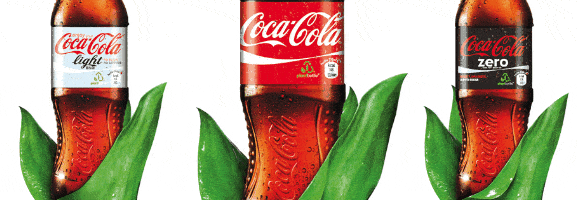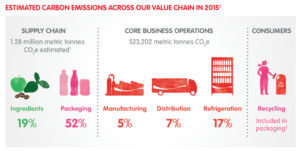Coca-Cola: Global Sustainability, Local Controversy

Coca-Cola: Global Sustainability, Local Controversy
It may seem counterintuitive to associate Coca-Cola with our planet – what does a sweet, syrupy mystery soda have to do with climate change? Despite the many degrees of removal of its final product from the earth, Coca-Cola has not only recognized the current and potential future impact of climate change on its business, but has begun to take action by investing in sustainable practices up and down its supply chain. Still, vocal activists, especially in developing countries, insist there is much more Coke can do.
Climate Change: A Looming Threat
Climate change has the potential to affect Coca-Cola’s operations in several ways: first, changing weather patterns may affect the supply of key raw materials, such as sugarcane, corn, and coffee. Secondly, unpredictable changes in weather may disrupt Coca-Cola’s delivery mechanisms or even product demand. Finally, and perhaps most importantly, climate change may affect the availability of water – the primary ingredient in Coca-Cola products [1]. Jeffrey Seabright, Coke’s VP for Environment and Water Resources, explained how these events could, and have begun to, impact Coca-Cola’s bottom line: “Increased droughts, more unpredictable variability, 100-year floods every two years. When we look at our most essential ingredients, we see those events as threats” [2].
Coca-Cola’s Three-Pronged Response
Coke has implemented a robust sustainability program to address the threat of climate change – and to mitigate its own complicity in global warming as one of the world’s largest CPG manufacturers. The below infographic lays out Coke’s contribution to carbon emissions across different parts of the production process.
According to Coca-Cola’s Position Statement on Climate Protection [3], the company is focusing on reducing emissions in three key areas:
Manufacturing Plants
Coca-Cola set a goal to reduce overall manufacturing-related emissions by 5% by 2015. While this seems like an incremental improvement, Coke claims its efforts have saved the company $600M since 2004 [4]. These include both “quick fixes” – such as repairing leaks and optimizing factory temperatures – and larger investments, like installing efficient lighting.
Distribution Fleet
While Coke has not set an explicit target for reducing the emissions of its distribution fleet, it has launched fuel efficiency experiments for its 200,000 delivery vehicles. In several developing countries, Coca-Cola has tested various alternatives to traditional fuel, like trucks powered by electricity, diesel, or natural gas. In addition, Coke is examining its basic delivery operations by optimizing truck routes to reduce refuel, and trialing lighter-weight packaging [5].
Cold Drink Equipment
Coca-Cola has set aggressive targets to reduce the emissions of its cold-drink equipment. The Global Warming Potential (GWP) metric measures how much heat a particular gas traps in the atmosphere, relative to carbon dioxide (which has a GWP of 1). Hydrofluorocarbons (HFCs), a common refrigerant, have a GWP of 3790 over 20 years [6]. The Kyoto Protocol also specified HFCs as a gas to be reduced, leading Coca-Cola to set a target to completely phase out HFCs in its cold drink refrigerators by 2015. Unfortunately, Coca-Cola reported in its 2014/2015 Sustainability Report that it was not on-track to reach this goal, citing high costs and difficulty of procuring equipment in certain markets. Still, about 30% of new equipment purchases in 2014 were HFC-free, and Coke claims to have invested over $100M over the last decade to increase the efficiency of its cold drink equipment [7].
A Path Forward: Focus on Localization
Despite these efforts, Coca-Cola continues to face controversy and opposition from governments and activists over sustainability practices. In India, for example, Coca-Cola is seen as being a major contributor to groundwater depletion. Vocal protests have led to scrapped plants and 2 closures over the last few years, despite India being declared a focus market for Coke in 2012 [8].
All this happened in the wake of Coca-Cola’s prominently marketed water replenishment program, which claims the company has replenished over 115% of its water consumption to local communities [9]. Dissident activists point out that “water neutrality” is a deceptive concept, because “…water issues are local in their impact…the impacts are borne by the local communities and farmers that depend upon it to meet their water needs. Replenishing an aquifer hundreds of miles away from the point of extraction, as Coca-Cola has often done to ‘balance’ their water use, has no bearing on the health of the local aquifer which Coca-Cola depletes through its bottling operations…” [10].
These protests suggest that although climate change is undeniably a global problem, its effects are felt most acutely at the local level. By implementing global sustainability programs, and more importantly, measuring the success of those programs through global statistics, Coca-Cola obscures the true impact of its actions on local communities. Going forward, Coca-Cola should deploy hyper-localized sustainability practices to combat the human effects of climate change, as opposed to striving for blanket solutions across all its markets. (Word count: 799)
Sources:
- The Coca Cola Company. (2016). 2015 10-K form. Retrieved from http://www.coca-colacompany.com/.
- Davenport, Coral. “Industry Awakens to Threat of Climate Change.” The New York Times, 23 Jan. 2014, http://www.nytimes.com/2014/01/24/science/earth/threat-to-bottom-line-spurs-action-on-climate.html. [Accessed 02 Nov 2016].
- The Coca-Cola Company. 2016. Position Statement on Climate Protection: The Coca-Cola Company. [ONLINE] Available at: http://www.coca-colacompany.com/stories/position-statement-on-climate-protection. [Accessed 02 November 2016].
- The Coca-Cola Company. 2016. Offices & Bottling Plants: The Coca-Cola Company. [ONLINE] Available at: http://www.coca-colacompany.com/stories/offices-bottling-plants. [Accessed 02 November 2016].
- The Coca-Cola Company. 2016. Refuel: The Coca-Cola Company. [ONLINE] Available at: http://www.coca-colacompany.com/stories/refuel. [Accessed 03 November 2016].
- Wikipedia. 2016. Global warming potential – Wikipedia. [ONLINE] Available at: https://en.wikipedia.org/wiki/Global_warming_potential. [Accessed 04 November 2016].
- http://www.coca-colacompany.com/content/dam/journey/us/en/private/fileassets/pdf/2015/09/2014-2015-sustainability-report.pdf
- Preetika Rana. 2016. Coca-Cola Closes Plant in India – WSJ . [ONLINE] Available at: http://www.wsj.com/articles/coca-cola-closes-plant-in-india-1455122537. [Accessed 04 November 2016].
- The Coca-Cola Company. 2016. Collaborating to Replenish the Water We Use: The Coca-Cola Company. [ONLINE] Available at: http://www.coca-colacompany.com/stories/collaborating-to-replenish-the-water-we-use. [Accessed 04 November 2016].
- The Ecologist. 2016. Never mind the greenwash – Coca Cola can never be ‘water neutral’ – The Ecologist. [ONLINE] Available at: http://www.theecologist.org/blogs_and_comments/commentators/2985093/never_mind_the_greenwash_coca_cola_can_never_be_water_neutral.html. [Accessed 04 November 2016].




It definitely looks like Coca Cola is taking a leading role in water stewardship: http://www.coca-colacompany.com/sustainabilityreport/world/water-stewardship.html#section-mitigating-riskfor-communities-and-for-our-system. Which initiatives seem the most promising / impactful?
I wonder what role competitors have played in encouraging Coca Cola take this initiative. Is Coca Cola the first mover, or has Pepsi pursued similar initiatives? As you’ve alluded to, one incentive for Coca Cola to invest in sustainable practices is to avoid negative PR. But if Pepsi is doing the same thing, is negative PR a real threat?
Thanks for posting Ldubs. I’m always blown away by the severity of the negative impact that some of these large companies have on local communities. I wouldn’t have known that they play such a big role in groundwater depletion. One issue that bothers me is how the 3 areas that the company is focusing on reducing its emissions in are the three areas that have the lowest contribution. They don’t mention in their strategy any plans for reducing their supply chain carbon emissions which equate to 71% of their estimated emissions. I imagine they chose not to tackle the bigger issue due to financial reasons, or because the ‘behind the scenes’ sources of emissions have less of a PR risk, but they would probably benefit in the long term if they invested in R&D to improve the efficiency of their packaging. Additionally, if they were to develop a revolutionary approach to beverage packaging there could be an opportunity to benefit financially from patenting and/or selling the rights.
Ldubs, appreciate the post, and definitely agree that localizing the solutions is the way to go. This is really the only way to address Anthony’s concern over the packaging emissions which account for 52% of their emissions. Looking at some of the things Coca-Cola has done, it looks like they have made some progress in things such as their use of Bioplastics, but I do wonder about the financial viability of this packaging in all markets. As Coca-Cola’s model of packaging operations involves the actual bottling and packaging occurring at the local level; I do believe there must be some ways in which the environmental impact can be reduced by thinking locally rather than globally. Innovation in product delivery can lead to this – Coca-Cola already has experimented heavily in trying different sizes and different price points to try and capture the sweet spot for each market. An extension of this approach could be something like Coca-Cola “fountains”, in which for a few cents, one could get a couple of sips of Coca-Cola with no packaging impact to worry about at all. In a lot of markets this would not be viable, but I have a strong feeling that in others it would be.